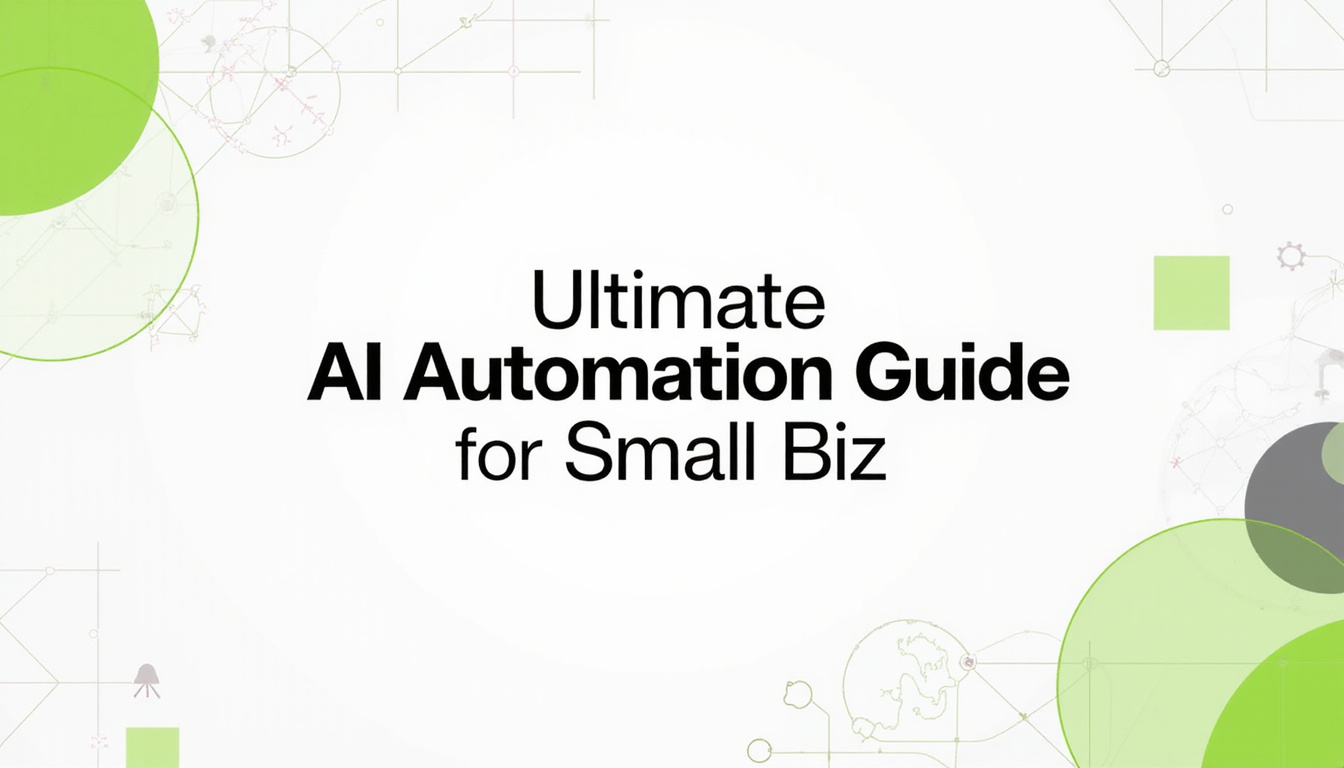The Ultimate Guide to AI Automation for Small Business: Simplifying Growth and Operational Efficiency
Estimated reading time: 25 minutes
Key Takeaways
- AI automation for small business combines software automation with AI to streamline repetitive tasks and improve decision-making.
- 75% of SMBs are experimenting with AI, and 68% already use it, showing rapid adoption.
- Start with high-volume, repetitive tasks like customer service, invoicing, or lead scoring for quick wins.
- No-code platforms make business process automation AI accessible without technical expertise.
- Measure ROI using time savings, error reduction, and revenue uplift to justify expansion.
- Human-in-the-loop approaches ensure quality control while scaling automation.
Table of Contents
- What is AI Automation and Why Small Businesses Need It
- Key AI Automation Solutions for SMBs — Tools & Technologies
- Step-by-Step Guide: How to Implement AI Automation in Small Business
- Real-Life Case Studies of Small Businesses Succeeding with AI Automation
- Measuring ROI and Continuous Improvement
- Common Mistakes and How to Avoid Them
Small businesses run on people doing a thousand small tasks well. But repetitive work — answering the same customer questions, processing invoices, qualifying leads — eats time and margin. That’s why learning how to apply AI the right way matters now: it frees people to do higher-value work while improving speed and accuracy.
AI is already part of the SMB story. Seventy-five percent of SMBs are at least experimenting with AI; growing SMBs lead at 83%. Source: Salesforce SMB AI trends (2025). And 68% of small-business owners report already using AI, with another 9% planning adoption within a year. Source: Fox Business (small-business AI adoption).
This guide is for business owners, operators, and managers who want a clear, low-risk path from curiosity to measurable results using AI automation for small business. You’ll get plain-language definitions, a step-by-step implementation roadmap, a vendor checklist, an implementation pilot template, a downloadable readiness checklist, a tool comparison matrix, an ROI calculator, and three real-world case studies that show what’s achievable fast.
No-code options make AI accessible even without data-science hires, and many SMBs report tangible margin and scale benefits from practical pilots. Source: Vendasta on no-code and SMB growth. Ready to see where AI can help your business first? Take our quick readiness quiz below to get a recommended starter pilot and a downloadable checklist.
What is AI Automation and Why Small Businesses Need It
AI automation for small business means combining software automation with AI capabilities to remove routine work, speed decisions, and give teams time back for customer and growth work.
Plain-language definition
AI automation for small business: Combining software automation (rules-driven workflows and robotic process automation) with AI components (machine learning, natural language processing, and predictive models) to automate repetitive tasks, surface insights from data, and augment employee decision-making in small and medium-sized businesses.
How automation and AI differ — and why both matter
- Automation (plain): Rules-driven systems or scripts that do predictable tasks — e.g., move a support ticket to “billing” if a customer selects that option. Automation is great for structured, repeatable tasks.
- AI (plain): Pattern-recognition and decision-making tools — e.g., models that read emails and suggest the right reply or that predict which leads are likely to convert. AI handles fuzzy data and adapts over time.
- Together: Automation does the heavy-lifting; AI supplies judgment and flexibility. For example, an automated workflow routes invoices while AI classifies line items and flags suspicious ones.
Myths vs. Reality
Myth: AI is only for big companies.
Reality: No-code platforms and off-the-shelf services let SMBs adopt business process automation AI for targeted workflows without custom models. Source: Vendasta on no-code and SMB growth.
Myth: AI will replace my team.
Reality: Most SMB owners say AI enhances the workforce and helps them grow. AI often reduces repetitive tasks and lets employees focus on higher-value activities. Source: Fox Business on SMB AI sentiment.
Myth: AI always delivers big results immediately.
Reality: Simple pilots for high-volume tasks produce measurable wins in weeks; bigger, cross-system projects take phased rollout and governance. Expect iterative improvement and model monitoring.
Top SMB pain points AI addresses
- Slow customer response times and backlogs.
- Hours spent on manual invoice entry and reconciliation.
- Low outbound sales throughput and inconsistent qualification.
- Marketing personalization at scale without extra headcount.
- Data entry errors, missed discounts, and slow approvals.
Barriers and risks
- Talent & time: SMBs often lack AI specialists and time to manage integrations. Source: Techaisle AI adoption trends.
- Data quality: Bad or inconsistent data lowers accuracy; expect a data-cleanup phase.
- Integration friction: Plugging AI tools into legacy systems takes planning.
Why act now
SMBs using AI report scaling operations and improved margins: 87% say AI helps scale operations, and 86% report improved margins. Source: Salesforce SMB AI trends (2025). That kind of uplift can fund further investment and hiring.
Interactive quick self-assessment quiz
- Quiz: 8 questions to gauge readiness (see quiz full version in Interactive Assets section).
- Scoring: 0–2 = Low readiness; 3–5 = Medium; 6–8 = High-priority automation candidate.
- Outcome: Personalized recommended starter pilot and CTA to download the implementation checklist.
Key AI Automation Solutions for SMBs — Tools & Technologies
If you’re an owner or operator evaluating options, this section walks through the most practical AI tools for entrepreneurs and how to choose based on function, data needs, costs, and time-to-value.
Customer service
- Common automations: FAQ chatbots, triage and ticket routing, agent assist (suggested replies), case summarization.
- Tech: NLP for text understanding, RPA for moving data between systems, human-in-the-loop for escalation.
- Expected outcomes: Faster first response time, lower Average Handle Time (AHT), higher CSAT.
- Typical cost tiers: $30–$300+/month depending on chat volume and integrations.
- Time-to-value: 2–8 weeks for a focused FAQ bot and agent-assist integration.
- Data needs: Conversation logs (ideally 500–2,000 transcripts or a list of top 50 FAQs), helpdesk API access.
- Example: Deploy a knowledge-base-driven chatbot that resolves 20–30% of repetitive tickets while routing edge cases to agents.
For tactical templates and playbooks on building support bots, see the AI Chatbots playbook.
Sales
- Common automations: Lead scoring, email drafting and personalization, next-best-action prompts, meeting scheduling.
- Tech: ML for scoring, NLP for email drafts.
- Expected outcomes: Higher lead-to-opportunity rate and more meetings per rep.
- Typical cost tiers: $50–$400+/month depending on CRM integration and model sophistication.
- Time-to-value: 4–12 weeks (depends on CRM data readiness).
- Data needs: 3–12 months of CRM history with conversion labels for effective lead scoring.
- Example: A lightweight scoring model surfaces the top 20% of leads responsible for 80% of pipeline movement.
For tactics to increase pipeline quality and outreach, see our Lead Generation resources.
Marketing
- Common automations: Content suggestions, ad targeting optimization, segmentation, A/B testing automation.
- Tech: ML for audience segmentation, generative models for draft content, automation for campaign workflows.
- Expected outcomes: Higher conversion rates and faster content cycles.
- Typical cost tiers: $20–$500+/month depending on features and volume.
- Time-to-value: 2–8 weeks for campaign optimization; 4–12 for content-driven programs.
- Data needs: Historical campaign performance, conversion events, CRMs for personalization.
<h3 style=”border-bottom: 2px solid #00c2ff; padding-bottom: 5px; font-size: 22px !important; color: #ffffff !important



